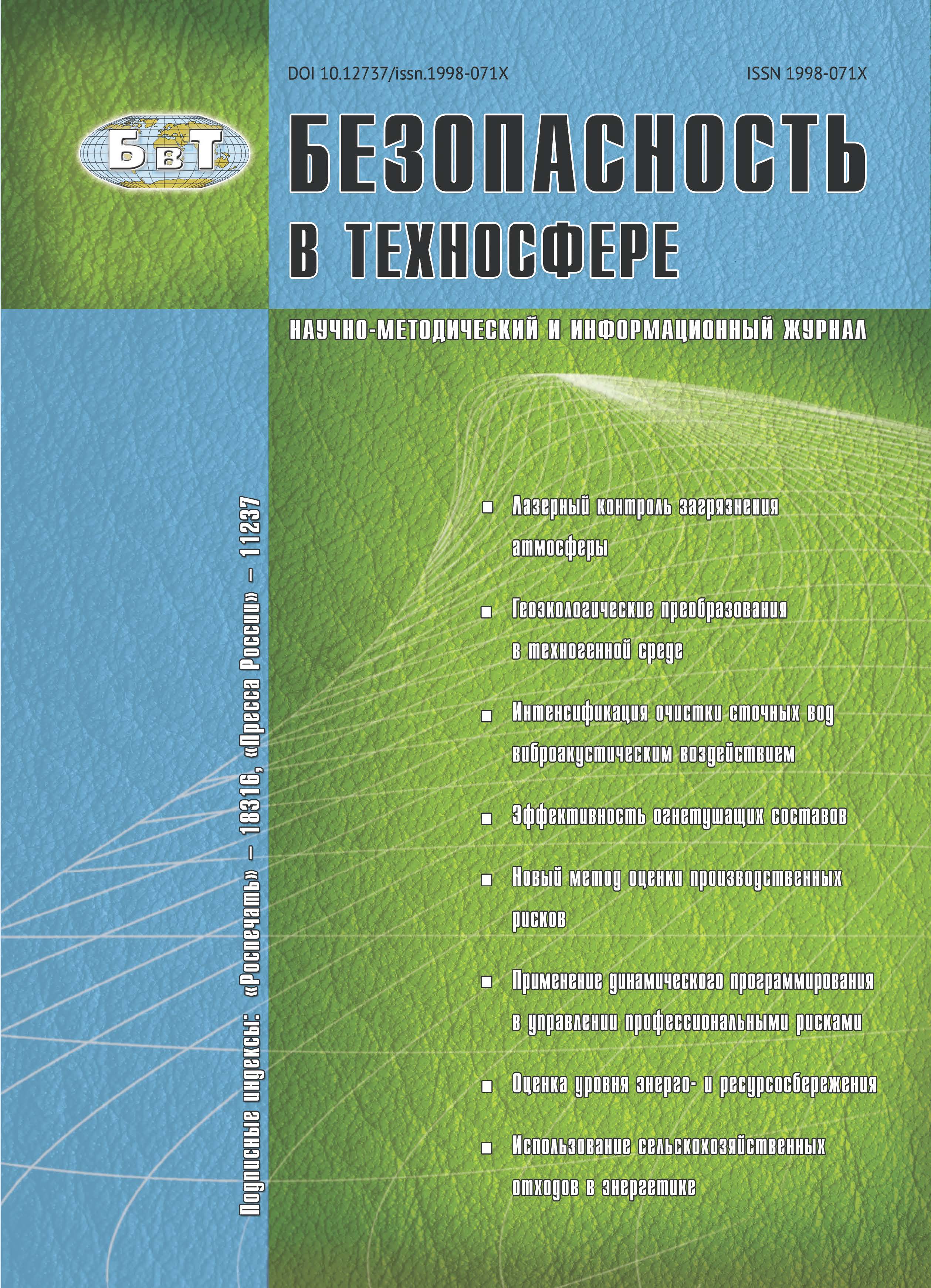from 01.01.1997 until now
Moscow, Moscow, Russian Federation
The process of waste water treatment by floatation using ejector system of aeration has been considered in this paper. The system’s main shortcoming has been noted: receipt of large bubbles with a diameter about 1 mm, that not always allows get a high performance of cleaning. It has been noted that the most effectively the process of floatation treatment for industrial sewage from fine pollutions is performed when the bubbles’ sizes are less than 100 microns, and when there is a big range of pollutions in water it is reasonable to receive the bubbles with a wide disperse structure. The carried-out overview of Russian and foreign sources has demonstrated that the main shortcomings of existing dispersion devices used for crushing of the bubbles generated by the ejector is insufficient dispersion extent in case of low gas content, work instability, technology complexity. For sewage treatment process intensification and remedial action of the existing devices has been offered a combined aeration system consisting of ejector and original dispersing device. On laboratory installation have been conducted experimental studies on determination of disperse composition for air-and-water mix generated by the offered aeration system. The received results confirm a possibility for receipt of fine bubbles in the range of 20–300 microns with a degree of bubbles of fraction less than 100 microns up to 80 %, and with an average diameter of 60–80 microns. A feature of the bubbles’ disperse structure has been noted: allocation from it several groups of bubbles with different values of average diameters. This feature can be used for intensification of process for water treatment from pollutions with various floatability degrees. Dependences of researched characteristics on dispersant’s diameter and height have been presented. They allow perform a choice of dispersant’s geometrical parameters for receipt of the air-and-water mix’s required disperse composition aimed to management of floatation process.
floatation sewage treatment, ejector, dispersant, aeration system, bubble diameter, waste water purification efficiency
1. Введение
Известно, что эффективность процесса флотационной очистки воды в значительной степени зависит от способов и устройств аэрации воды [1–3]. Для этих целей применяется несколько способов и множество различных аппаратов и устройств. Аэрирование воды при помощи эжекторных устройств получило широкое распространение благодаря простоте их конструкции, высокой надежности, экономичности применения [4, 5]. Однако применение эжекционной системы аэрации при флотационной очистке сточных вод не так широко распространено в связи с недостатками, основной из которых — получение крупных пузырьков воздуха диаметром около 1 мм, в то время как оптимальный диаметр пузырька для извлечения тонкодисперсных загрязнений составляет 50–90 мкм [3]. Следует отметить, что в случае присутствия в сточной воде большого спектра загрязнений, причем каждое загрязнение наиболее эффективно удаляется пузырьком определенного диаметра, целесообразно получать пузырьки широкого дисперсного состава. Поэтому для интенсификации процесса очистки воды с использованием эжекторов предлагается использовать дополнительные устройства диспергирования.
1. Ksenofontov B. S. Flotatsionnaya mashina dlya ochistki stochnykh vod. / B S. Ksenofontov, E. S. Antonova.. Patent na poleznuyu model´ № 149273 RF, C02F1/24. Zayav. 24.02.2014; Opubl. 27.12. 2014. Byul. № 36. 5 s.
2. Ksenofontov B. S. Flotatsionnaya obrabotka vody, otkhodov i pochvy. - M.: Novye tekhnologii, 2010. - 272 s.
3. Ksenofontov B. S., Antonova E. S. Optimizatsiya flotatsionnoy ochistki stochnykh vod. Vodoochistka, - 2015.- № 3. S. 20-24.
4. Voronov Yu. V., Kazakov V. D., Tolstoy M. Yu. Struynaya aeratsiya. Nauchnoe izdanie. - M.: Izdatel´stvo Assotsiatsii stroitel´nykh vuzov, 2007. - 216 s
5. Grinis L., Lubashevsky N., Ostrovski Y. Influence of the flow rate ratio in a jet pump on the size of air bubbles. International Journal of Mechanical, Aerospace, Industrial, Mechatronic and Manufacturing Engineering. - 2015. - vol. 9. - № 7. - pp. 1161-1164
6. Fernanda Yumi Ushikubo. Fundamental Studies on the State of Water with the Generation of Micro and Nanobubbles. A dissertation … of Doctor of Philosophy. Tokyo, 2010. - 112 p.
7. Akimi Serizawa, Tomohiko Inui, Toshihiko Yahiro, Zensaku Kawara. Laminarization of micro-bubble containing milky bubbly flow in a pipe. / 3rd European-Japanese Two-Phase Flow Group Meeting. (Certosa di Pontignano, Italy. 21-27 September 2003). - 2003. - 8 p. Rezhim dostupa: http://aura-tec.com/pdf/03-milky.pdf (Data obrashcheniya: 21.10.2016)
8. Sadatomi Michio, Kawahara Akimaro, Matsuura Hidetoshi, Shikatani Shinji. Micro-bubble generation rate and bubble dissolution rate into water by a simple multi-fluid mixer with orifice and porous tube.. Experimental Thermal and Fluid Science. - 2012. - vol 41. - pp. 23-30.
9. Koichi Terasaka, Ai Hirabayashi, Takanori Nishino, Satoko Fujioka, Daisuke Kobayashi. Development of microbubble aerator for waste water treatment using aerobic activated sludge.. Chemical engineering science. - 2011. - vol. 66. - № 14. - pp 3172-3179.
10. Chen Fu-tai, Peng Feng-xian, Wu Xiao-qing, Luan Zhaokun, Bubble performance of a novel dissolved air flotation (DAF) unit. Journal of Environmental Sciences. - 2004. Vol. 16, - № 1. - pp. 104-107.
11. Rodrigues R. T., Rubio J. New basis for measuring the size distribution of bubbles //Minerals Engineering. - 2003. - vol. 16, - № 8. - pp. 757-765.
12. Bochkarev G. R Ustanovka dlya flotatsionnoy ochistki vody / G. R. Bochkarev, S. A. Kondrat´ev. Patent RF № 2251530, C02F1/24. Zayav. 24.02.2004; Opubl. 10.05. 2005. Byul. № 13.
13. Grishin L. B. Sovershenstvovanie ochistki neftesoderzhashchikh proizvodstvennykh stochnykh vod. Diss. … kand. tekhn. nauk - Penza: GOU VPO “Penzenskiy gosudarstvennyy universitet arkhitektury i stroitel´stva”, - 2009. - 144 s.
14. Gmurman V E. Teoriya veroyatnostey i matematicheskaya statistika: uchebnoe posobie dlya vuzov. - M: Vysshaya shkola, 2003-479 s.
15. Blaznov A. N., Denisov Yu. N., Kunichan V. A., Chashchilov D. V. Raspredelenie puzyr´kov po razmeram v zhidkostno-gazovykh struynykh apparatakh s udlinennoy kameroy smesheniya. Elektronnyy zhurnal “Issledovano v Rossii.” - 2002. - S. 663-670.






